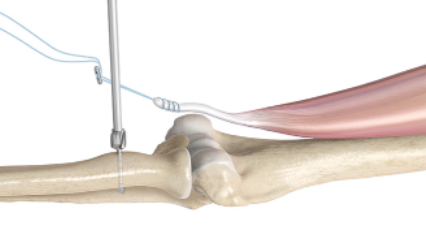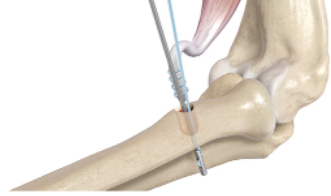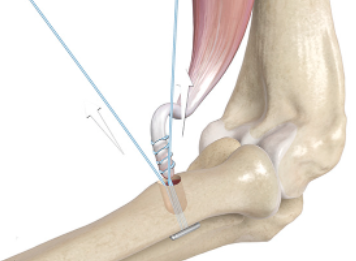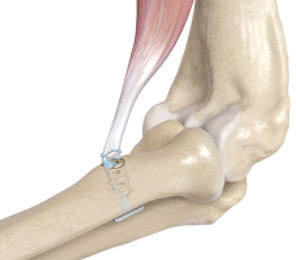Distal Biceps Tendon Repair Surgery
(Repair the Biceps Tendon from the Elbow)
Your Diagnosis
Distal biceps tendon surgery is done to help people when their biceps is torn from its connection to the elbow. See Distal Biceps Tendon Tear section.
What happens during Surgery?
Surgery takes between 30 and 45 minutes. It is done with general anesthesia, meaning the person is asleep. During surgery a 1.5 inch incision is made on the front of the elbow in the flexion crease. The torn tendon is cleaned up. It is then secured into the bone using an endobutton (see pictures).
Immediately after Surgery
The
person will wake from surgery in the recovery room where they will spend 1
to 3 hours. Most people will then be
allowed to go home when they are awake enough. The person will go home in a
sling. The person cannot drive or take public transportation home. They must
have a ride.
A person may have questions following your surgery. Many of these frequently asked questions surgery questions can be answered here.
Therapy after Surgery
After distal biceps tendon surgery, the person will be given Biceps Precautions for the first 6 weeks after surgery. Range-of-motion therapy under the guidance of a therapist will usually begin right away.
What to expect after Surgery: week 0 through week 6 (Phase One)
- Pain: Right after surgery, the elbow will hurt. Pain is expected. The person will be given pain medications to go home with. The pain medications will help with the pain but will not remove the pain. By day 5 after surgery almost all people have stopped taking the pain medication. It is important to stop taking the pain medications because pain at the repair site is protective. People who continue to take the pain medications have a much greater chance of the surgery not working.
- Therapy: Therapy for elbow range-of-motion is usually started right away.
- Precautions: The arm is to be kept in a sling as desired by the person. The person can come out of the sling at any time. If the person removes the sling then the arm should be relaxed at the side with the elbow straight (not bent). The person cannot lift things with that arm.
- Work: If a person returns to work they must follow the above precautions.
What to expect after Surgery: week 6 through week 12 (Phase Two)
- Pain: Most people have minimal pain at this point.
- Therapy: At this point a lightweight, high repetition strengthening therapy program will start. Range-of-motion therapy is usually not needed beyond 6 weeks.
- Precautions: The person will be allowed to start using their elbow for normal daily activities such as opening a car door, driving, opening the refrigerator, lifting a box, etc. Heavy lifting should be avoided.
- Work: Most people with desk jobs have returned to work. Those with manual labor jobs usually cannot return to work until after the arm has been strengthened.
What to expect after Surgery: week 12 through 1 year and beyond (Phase Three)
- Pain: Most people have minimal to no pain.
- Therapy: Most people have stopped formal therapy.
- Precautions: Usually there are no precautions by week 12. The person is usually doing most of their normal activities. Heavy lifting is ok.
- Work: Most people (even manual laborers) have returned to work.

The metal button (endobutton) is sewn to the end of the biceps tendon and a hole is created in the radius bone.

The end of the biceps tendon and the endobutton are passed through the bone.

The metal button is flipped so that it lays flush against the outside of the bone, and the biceps tendon is buried within the bone.
